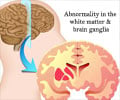People with serious cases of writer’s cramp have brain abnormalities, according to a study published in the medical journal of the American Academy of Neurology. People with writer’s cramp had less brain tissue than healthy people in three areas of the brain that connect the senses and movement with their affected hand.
Writer’s cramp is a form of dystonia, an involuntary, sustained muscle contraction. Writer’s cramp often occurs in people who have used the same muscles repeatedly for years.The study involved 30 people who had writer’s cramp for an average of seven years with no other forms of dystonia. Using brain imaging, the researchers compared the brains of those with writer’s cramp to 30 healthy people.
The researchers found that those with writer’s cramp had less grey matter in three areas of the brain: the cerebellum, the thalamus, and the sensorimotor cortex.
“It’s not clear whether these abnormalities are a cause or a result of the disease,” said study author Stéphane Lehéricy, MD, PhD, of Salpêtrière Hospital in Paris, France. “The fact that the brain abnormalities are in the areas that control the affected hand suggests that these differences are specific to this problem.”
“Another theory is that the brain structure changed and adapted as a result of the sustained repetitive movement,” Lehéricy said. “Studies have shown that people with no dystonia can experience brain changes due to learning new information, which supports this theory.”
The study was supported by grants from Salpêtrière Hospital in Paris, the Action Concertée Incitative, and INSERM, the French National Institute for Health and Medical Research.
Advertisement
Source-NEWSWISE
LIN/B










